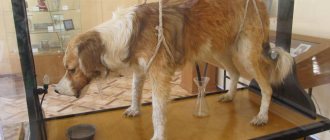Dogs are absolutely amazing creatures. Smiles often appear on their faces, which seem more sincere than human ones.
It is this sincere joy that evokes reciprocal feelings: even an ordinary cartoon dog can make both children and adults laugh.
What is attractive about cartoons about dogs?
- Firstly, of course, emotionality , which animators diligently put into dog faces.
- [adsright]Secondly, sincerity : in cartoons about dogs, both resentment and joy are expressed vividly and directly.
- Thirdly, the curiosity of the situations. The reputation of naive pranksters that shaggy ones have gained has played into the hands of cartoon creators: films about dogs turn out to be the funniest and most educational.
Often, in a dog’s “face,” the director makes fun of human vices, character traits, or uses the “human” world in the film for this purpose.
Let's see what ratings of cartoons about dogs were recently compiled based on surveys.
"Once upon a time there was a dog"
Duration: 10 minutes 36 seconds. Country: USSR.
The idea of mutual aid is at the heart of this Soviet cartoon , just as it is at the heart of many others (for example, Lady and the Tramp). It’s just played out here a little differently.
The owners of the farm drive out the Dog, an old, frail guard: the dog’s “incompetence” is confirmed by the unpunished theft.
The homeless Dog goes into the forest, where he meets his main enemy - the Wolf, who unexpectedly decides to help him.
The Wolf imitates the theft of a child and is driven out in disgrace by the Dog, after which the owners return the hero-savior home.
Feeling like he owes the Wolf, the Dog quietly leads him into the hut under the table, to the wedding of the owner’s daughter. The enraged Wolf betrays himself with loud lyrics after the sacramental “And now I’ll definitely sing!”, but the Dog saves him from his owners, “driving” him into the forest.
The predator, who has come to his senses, thanks the dog, and they part as friends. At the end there is a catchphrase: “Come in if anything happens...”.
The cartoon captivates with the simplicity and sincerity of the characters, as well as a certain realism of the plot.
Watch now:
Once upon a time there was a dog
Films about horses and teenagers ->
Background
Togo and Balto lived in the gold mining village of Nome in northwestern Alaska. Both grew up in the kennel of Leonardo Seppala, a famous musher, dog handler, trainer, and high-class sled dog racer.
Balto is a black and white half-breed husky.
Born in 1919. Received a nickname after the Norwegian scientist and traveler Samuel Balto. He never participated in sports races, but he coped with the duties of a working sled dog excellently.
The mushers considered the dog too slow for racing, so they assigned him to deliver food around the city. This does not require speed, but strength and endurance are required.
Togo is a blue-eyed husky with agouti color.
Togo is 6 years older. He was born in 1913 to a purebred Siberian husky, Dolly, and the leader dog from Leonardo Seppala's pack, named Saggen. The puppy turned out to be the only one in the litter, grew stubborn, sickly, and was underweight.
Seppala considered it unsuitable for sled dog racing. I tried to give it to friends twice. But the naughty dog did not get along with his new owners and returned every time.
One day Seppala and his dogs went to the prospectors' camp. He left him in the pen so that he would not interfere with the long trip. The next day, the puppy got out, having injured its paw, and caught up with the team. This day changed his life.
Seppala decided to put the stubborn pet in a harness and observe. Togo, with a bandaged paw, tirelessly pulled the sled 120 km, working harder than adult dogs. By evening the musher placed him next to the leader. From that day on, Leonard and Togo were never separated. The dog remained the constant leader of the team, won sports races, and became famous throughout Alaska.
Seppala would later say: “I found the natural leader I had been trying to cultivate for years.”
Epidemic
In 1925 the gold rush died down. Nome has turned into a calm town with a population of about one and a half thousand people. The diphtheria outbreak broke out in winter. It was the coldest, windiest and snowiest year in 20 years.
Noma's only doctor, Curtis Welch, was the first to sound the alarm when children began to get sick and die. All had dangerously high temperatures, clear signs of diphtheria.
The doctor immediately realized what catastrophic consequences the disease could bring. Diphtheria spreads at a devastating rate and is fatal without treatment, especially for children.
The only drug available for diphtheria in 1925 was antitoxic serum. She could stop the epidemic and help people who were already sick. There were vaccine supplies remaining in Nome, but the expiration date had expired.
Curtis Welch urgently met with the mayor of Nome, who radioed for help. The closest city where the required amount of vaccine was found was Anchorage, a thousand kilometers from Nome.
An Arctic storm over Alaska has disrupted air and sea transport. Therefore, the medicine was sent by train to the settlement of Nenana, where the railway tracks intersected with the trail leading to Nome. From here the serum could be delivered in the only way - transported by sled.
Balto's fate after the race
After the run, Kaasen and Balto became American heroes.
Producer and promoter Sol Lesser made a half-hour film about them and organized a tour of the United States. Photos and messages about the heroes did not leave the front pages of the press. The culmination was the opening ceremony of the Balto monument in New York's Central Park.
Balto and Kaasen at the opening of the monument.
Over time, the excitement died down. Balto and the rest of the dogs were sold to a theater producer in Los Angeles. It is unknown what the fate of the animals would have been if businessman George Campbell had not seen them. Half-starved, unkempt dogs were put on chains, and when they tried to break free they were beaten mercilessly.
The businessman was outraged by the conditions in which the animals were kept. With the help of the media and public organizations, he quickly raised funds and bought the dogs. On December 17, 1927, he was given to the Cleveland Zoo.
Balto with children at the Cleveland Zoo.
On the first day, 15 thousand visitors came to see Balto. A sign with a story about their exploits was attached to the enclosure. They took excursions to him, children, and painted pictures.
Balto lived for 14 years and died in 1933 at the Cleveland Zoo. His body was mummified and placed in a local museum.
The Great Run to Nome has repeatedly inspired writers and directors. In the 1970s, the popular American writer Seymour Wraith published the novel Race Against Death. Margaret Davidson wrote the children's story Balto: The Dog Who Saved Nome. A cartoon was released in 1995. The audience liked the animated story of Balto so much that the authors filmed 2 more episodes.
Togo's life after the race
Togo did not receive as much media attention, which greatly hurt Seppala. The racer was upset when journalists belittled the merits of his favorite or attributed his achievements to Balto. The musher said: “In Alaska, disrespect for dogs is offensive to their mushers.”
When the monument was erected in New York, Seppala repeatedly repeated that the statue was erected to the “wrong dog” and decided to tell the general public about the heroism of his favorite. In the fall of 1926, Leonard, Togo and a team of Siberian Huskies set off on a long journey across America.
In cities, Seppala walked along the central streets, gathering thousands of people around him. He did everything possible to make the world know about Togo. He talked about the dangers of crossing to Nome, posed with his pet in front of photographers, and starred in an advertisement for Lucky Strike cigarettes.
The highlight of the trip was a 10-day demonstration of the skills of Siberian huskies in New York's Madison Garden in front of an audience of thousands. At one performance, the famous polar explorer Amundsen came out, gave a speech and awarded Togo a gold medal.
After the trip, Seppala continued to compete and win races. Togo no longer participated in sports competitions. In the nursery he was used as a stud male to improve the Husky breed. Puppies from the Seppala Siberian sled line were in great demand.
Togo lived for 16 years. In 1929, he became blind, suffered from joint pain, and Leonard had to euthanize his pet. The dog's body was embalmed and placed in a sled dog museum near Anchorage.
A monument to Togo stands in Seward Park in New York.
In 2022, two films were released in which he played a leading role: “The Great Race in Alaska” and “Togo.”
Seppala died in 1967. Until the end of his life, he called Togo the most devoted, hardy and intelligent of all his students. In honor of the legendary racer, the Iditarod Trail Seppala was organized along the trail of the race of mercy. Now the sled dog competition from Anchorage to Nome is held annually.
Great Race
The drivers and dogs had to cover a distance of 1085 km from Nenana to Nome. The race began on January 27, 1925. 20 mushers and 150 sled dogs took part in it.
They divided into 2 groups: the first started from Nenana, the second moved towards from Nome. Each driver and team walked their own part of the route and passed the serum to the next one.
Togo
Seppala's team consisted of 6 dogs led by Togo, she got the most dangerous and longest route of 146 km. However, in reality they ran a record 425 km.
Leonard started from Nome and covered three hundred kilometers. On January 31, in the vicinity of the settlement of Shaktulik, he met with musher Henry Ivanov, who was transporting serum on his site. In a snowstorm they almost missed each other. But Togo noticed the sled, and Leonard managed to stop, took the medicine and immediately turned around to head back.
The team moved at night, in a snow storm. The route ran through Norton Sound. Seppala did not go around the dangerous area along the coast. He moved directly, along the ice, to shorten the path and save a whole day.
Due to sea currents and gusty winds, the ice constantly moved, became covered with cracks, and broke off in huge pieces. At any moment the team could fall into the water or go into the open sea. Only the incredible instinct of the leader Togo helped him avoid dangerous areas, move in the right direction, and not lose his way in the pitch darkness.
Trail from Nenana to Nome.
On February 1, the team reached a roadhouse in Golovin, where Seppala gave the serum to the next musher, Charlie Olson. The exhausted dogs immediately lay down exhausted. Togo lost his paws, he could no longer run anywhere. Leonard feared the 12-year-old dog would not survive the rigors of the transition. But Togo recovered and survived.
Balto
At the finishing stage, the vaccine was carried by the Norwegian musher Gunnar Kaasen. He put Balto at the head of the team, although the dog had never been a leader before. Seppala called him average, but Kaasen had a different opinion.
Kaasen appreciated Balto's calm disposition and physical strength.
That day it was 34 degrees below zero, the wind increased to 64 km/h, and a snow storm arose. Gunnar couldn’t see anything at arm’s length, stopped getting his bearings and relied only on Balto’s instincts.
And the dog lived up to expectations. Near the Topkok River, he suddenly stopped the team at the very cliff, which saved the lives of the entire team. The gusts of wind were so strong that the sled overturned, and the cylinder with the serum fell out. Gunnar barely found a cure. While shoveling snow in search of serum, he froze his hands, could not control the team properly and completely trusted Balto.
Gunnar had to walk 52 km and hand over the serum to the last driver, Ed Ron. But he received a radio message about the suspension of the race due to an extreme hurricane and fell asleep. Kaasen did not know about the storm warning, did not wake up his comrade and continued on his way without delay.
On February 2, early in the morning, Balto and his team reached Nome.
They covered 85 km in a severe hurricane in 7 and a half hours. The diphtheria epidemic was stopped after 5 days, and on February 21, the quarantine was completely lifted.











